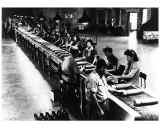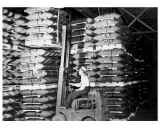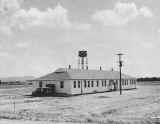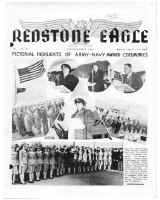1942
|
2 January 1942 The Office of the Chief of Engineers issued a construction directive for the building of a chemical warfare storage depot having facilities for the storage of 20 million units. Among the facilities to be erected were 200 concrete igloos. February 1942 to July 1945 There were eight fatalities in the Operations Division of Huntsville Arsenal: seven civilians and one Army officer. 1 February 1942 Major Hudson, Commanding Officer of Redstone Ordnance Plant, was promoted to lieutenant colonel. |
|
Contrary to existing thought at that time, Lieutenant Colonel Hudson began to lay plans for the employment of women in the event that manpower became scarce. Arrangements were made with the Civil Service Commission, which shortly announced job examinations for female trainees. At the time, the use of women was definitely frowned upon, but subsequent events more than justified Hudson's actions. By December 1942, about 40 percent of Redstone production line employees were women. 14 February 1942 The Adjutant General authorized the Chief of Engineers to begin construction of the Huntsville Chemical Warfare Depot as part of the Depot Storage Program. 28 February 1942 Huntsville Arsenal's first production emerged from a pilot line for M-54 incendiary bombs set up in Warehouse 642. This production continued intermittently until 21 April 1942, when fire destroyed the entire plant and its equipment. 28 February 1942 The first two ungraded (per diem) female employees were hired at Redstone Arsenal to work on the first production line. March 1942 Huntsville Arsenal's first production facility was activated. The arsenal became the sole manufacturer of colored smoke munitions and was also noted for its vast production of gel-type incendiaries. During WWII more than 27 million items of chemical munitions, with a total value of more than $134.5 million, were produced. Personnel of Huntsville Arsenal won the Army-Navy "E" Award four different times for their outstanding record in the production of war equipment. March 1942 Kershaw Butler Engineers, Limited, completed construction of one of two mustard gas filling plants at Huntsville Arsenal. A third plant was authorized but was ultimately adapted for incendiary oil munitions filling. These two mustard gas filling plants were more or less active until March 1944, when both were placed on standby. One of the plants was reactivated in October 1944 to fill an M-70 bomb schedule. After being placed in standby condition in January 1945, the plant was once again reopened in August 1945 for M-70 bomb filling. The schedule was canceled on 10 August 1945 in anticipation of the capitulation of Japan. |
|
1 March 1942 Redstone Ordnance Plant's first supervisor of training, supplied by the Alabama Department of Vocational Training, arrived. He planned and implemented the necessary classes to instruct the unskilled workers who made up the bulk of the available labor supply. 6 March 1942 The War Department formally activated the Huntsville Chemical Warfare Depot. Located in the extreme southern portion of Huntsville Arsenal, the depot received, stored, and issued Chemical Warfare Service materiel such as munitions, bulk chemicals, decontaminating apparatuses, and protective materials. 6 March 1942 General Order No. 5, issued on this date, established differing colors for the margins of the Redstone Ordnance Plant identification badge in order to confine workers to their respective areas. Red gained admittance anywhere on the reservation; white was the administrative area; blue was for the lines 1 and 2; orange was for lines 3 and 4; yellow was for the magazine area; and green was for the igloos. 12 March 1942 The main processing plant for the 4-pound M-54 thermate incendiary bomb was activated for production at Huntsville Arsenal. It operated until 21 April 1942, when the building was completely destroyed by fire. No further attempt was made to manufacture the M-54 bomb at Huntsville Arsenal after this time. Because there was no need for the storage buildings associated with the M-54 production line, they were torn down on 1 May 1942 and the lumber was salvaged. 20 March 1942 In compliance with a directive from higher headquarters, the Chief of Transportation at Redstone Ordnance Plant established a Share-A-Ride program on this date for the benefit of Redstone employees who were without transportation. Under this plan, the Army provided assistance in getting gasoline to those drivers with cars who were willing to transport fellow employees to and from work. The 1-2 percent of ride seekers not accommodated by this new program could not be assisted primarily because of residential isolation. 28 March 1942 The first production line began operation at Redstone Ordnance Plant. 6 April 1942 In conjunction with the city of Huntsville, Redstone Ordnance Plant participated for the first time in the national celebration of Army Day. Hudson spoke to both assembled plant employees and at the parade and celebration staged by the city. 7 April 1942 The first mustard gas produced at Huntsville Arsenal was made at Plant #1, Building 311. Between 8 May and 22 November 1942, five more mustard production plants began operations. They were shut down between 23 and 28 May 1943. Production officially ceased on the latter date. 7 April 1942 The two mustard gas filling plants at Huntsville Arsenal filled the first item of production (105mm M-60 shells). Both filling plants operated until March 1944, at which time they were placed in standby. The No. 2 plant was reactivated in October 1944, deactivated again in January 1945, and reactivated again in August 1945. The fact that mustard gas was never used in WWII caused much variance in the manufacturing program and schedules. 9 April 1942 Operation of the Clothing Renovating Plant at Huntsville Arsenal began on this date. The primary objective of the facility was to make permeable clothing protective against vesicant vapors by impregnating the clothing with a compound that neutralized the vapors. The plant's secondary objective included the laundering of impregnated clothing to remove soil or slight vesicant contamination, flameproofing of permeable clothing with an agent to make the material resistant to flames, and laundering of flameproofed clothing. 26 April 1942 The first medical officer was assigned temporarily to Redstone Ordnance Plant. 28 April 1942 The first loading and assembly line (#3) for chemical ammunition began operation at Redstone Ordnance Plant. It was called the "Redstone line" because of the many modifications made to the Picatinny Arsenal recommendations for equipment and material. This system of assembly proved to be efficient during a week-long experiment which compared the modified line with one that functioned on the original Picatinny recommendations. As a result, all of the loading and assembly lines for chemical ammunition at the installation began using the Redstone-designed equipment. April 1942 to May 43 During this period, production at Huntsville Arsenal was dependent upon the supply of components, the availability of trained personnel, and the successful operation of the manufacturing plant or filling line. There were no schedules to meet or forecasts to make. The prevailing idea was to produce everything possible as quickly as possible. The Army Supply Program subsequently showed that definite plans had to be formulated and schedules established so that end items produced at CWS arsenals would balance in a satisfactory manner. This program provided an overall picture to indicate quantities to be produced monthly as well as grand totals achieved by each CWS installation. |
|
15 May 1942 Huntsville Arsenal's only white phosphorus filling plant started production. Ten different munitions types were filled (including mortar shells and grenades) until production ceased on 14 August 1945. |
|
29 May 1942 The first carload of finished products left the Redstone Ordnance Plant classification yard |
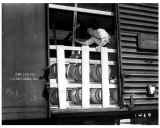
|
|
29 May 1942 To help alleviate the severe housing shortage caused by the construction of Huntsville Arsenal and Redstone Ordnance Plant, a contract was awarded for the construction of 300 family units on a tract of land near Farley, Alabama (southeast of the Army installations). Because of its proximity to the tracks of the Redstone Ordnance Plant spur of the Nashville, Chattanooga, and St. Louis Railroad, plans were laid to substitute rail transportation for inhabitants of the housing area should curtailment of motor transportation become necessary. |
|
7 July 1942 The Office of the Chief of Engineers authorized the construction of a Civilian War Housing, Dormitory Project for Huntsville Arsenal. A total of 18 dormitories capable of housing 24 persons were erected by the Chambers Lumber Company of Athens, Alabama. 31 July 1942 In compliance with guidelines to induct all guards into the Civilian Auxiliary Military Police (CAMP) under the authority of a commissioned officer, the entire guard force of the Redstone Ordnance Plant was read the Articles of War and inducted into the CAMP. August 1942 The Redstone Ordnance Plant hospital, a 29-room building, opened. The first patient of the new facility was the post surgeon, who suffered a fractured arm after being thrown from a horse. This hospital was inactivated on 30 June 1947, and all Surgeon General property and equipment were turned over to the Huntsville Arsenal Hospital. The latter facility subsequently provided medical services for the neighboring installation. 16 August 1942 The first baby was born in the Huntsville Arsenal Station Hospital. |
|
September 1942 The AN-M8 hand grenade, a smoke munition, began production at Huntsville Arsenal. Production continued on an intermittent basis until final termination in March 1945. October 1942 Production of colored smoke grenades at Huntsville Arsenal began. The dye used in the grenades colored the workers' clothing and stained their skin. Reportedly it was not uncommon to see people of rainbow hues in the Huntsville area. October 1942 The military strength (580) at Huntsville Arsenal reached its peak. October to November 1942 The manufacture of M-16 colored smoke grenades began at Huntsville Arsenal. An initial order for 30,000 grenades was filled during this period. Production of the M-16 grenade continued until the M-18 grenade superseded it on 16 November 1943. The daily capacity of the M-16 plant prior to its conversion was about 15,000 grenades per 24-hour work period. 1 October 1942 The Commanding General of Huntsville Arsenal was assigned additional duties as the Commanding General of the Huntsville Chemical Warfare Depot. 31 October 1942 In recognition of its outstanding production record, Huntsville Arsenal received the first of four Army-Navy "E" awards. November 1942 A plant safety organization was set up at Huntsville Arsenal under the guidance of the newly formed Industrial Safety Division. Progress in establishing a viable safety program was slow because the workers, both white and black, male and female, were drawn largely from the agrarian sector and had no industrial experience. Headway on safety practices was impeded further by the fact that many of the employees were illiterate and labor turnover was high. Also, because of the need to meet production goals, the time allowed for safety instruction was often too short to satisfactorily train workers in cautious practices. The weak link in safety supervision in the arsenal's Operation Division was at the line foreman level. Several of the sub-foremen were illiterate and none had had previous industrial experience. Too frequently in their zeal to get the end item made, too little attention was paid to job safety training, resulting in a high rate of accidents due to carelessness. November 1942 Production of white smoke munitions began at Huntsville Arsenal. Among the items produced were smoke pots, smoke shells, M-20 rifle grenades, and smoke canisters. Production of these types of munitions continued until Victory-Japan (V-J) Day. 2 November 1942 Production of the M-4 floating smoke pot began at one of Huntsville Arsenal's facilities. The limited capacity of this plant led to the construction of a larger line that began production in May 43. Production continued until 17 August 1943, when 2000 rejected smoke pots stored in a warehouse were set on fire by an ignited fuze lighter thrown into a pile of starter cups. A girl who was dismantling pots and had thrown the lighter was killed. The warehouse and its contents were a total loss. Production resumed in January 1944. It was discontinued in April 1944, when the M-4 was replaced by the M-4A2 floating smoke pot. 6 November 1942 The first Lewisite manufacturing plant began operations at Huntsville Arsenal, although its construction was not formally completed by Kershaw Butler until 18 November. By May 1943 three other Lewisite plants were in operation. All Lewisite manufacturing operations were permanently halted on 30 October 1943, and the plants were declared surplus in 1944. 9 November 1942 Huntsville Arsenal's Smoke and Incendiary Loading Department Branch Property Office, organized on this date, pioneered the use of War Department Shipping Documents, a new method for transferring property accountability. The Chemical Warfare Service selected the arsenal to be the first of its installations to implement the system. |
|
28 November 1942 The first Army-Navy "E" Award was conferred on Redstone Ordnance Plant. The presentation ceremony was held on 21 December 1942. |
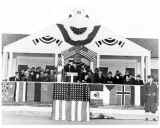
|
|
1 December 1942 Civilian barracks opened at Huntsville Arsenal. 22 December 1942 In accordance with instructions received from higher headquarters on 29 October 1942, Redstone Ordnance Plant prepared disaster plans to cope with such emergencies as fire, explosion, gas, electrical storm, riot, air raid and blackout, and paratroop invasion. |
The Pre-Missile Era: Introduction, 1941 , 1942 , 1943 , 1944 , 1945 , 1946 & 1947 , 1948 & 1949
